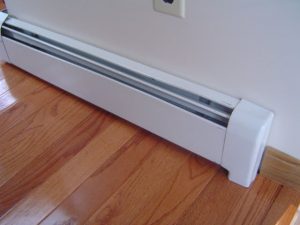The Pros and Cons of Hydronic and Electric Baseboard Heaters
By Mark J. Donovan
|
|
I remember back in the 1970’s my father installed electric baseboard heating in one of our new homes due to the fact that the United States had gone through a couple of oil shortages. The general belief in 1978 was that the world’s oil wells were drying up and that electricity would be relatively cheap in comparison to home heating oil.
Though oil prices have continued to rise over the past few decades, the cost of heating an entire home with electric baseboard heaters is still much more expensive than using hydronic baseboard heaters. |
Certainly the cost of installation of electric baseboard heaters is significantly cheaper than hydronic baseboard heaters. However the costs savings stop there. Hydronic baseboard heating uses hot water from your home’s existing hot water heating system to circulate hot water through the hydronic heating elements. The water is typically heated via gas or oil.
As hot water passes through the hydronic heating elements the energy is transferred from the water to the metal fins, where the energy in the form of heat then radiates upward out of the heating elements.
| Electric baseboard heating is similarly installed in each room of the home, however each room typically has its own thermostat. The one advantage of electric baseboard heating is the fact that you have more control of what rooms you heat in a home. Consequently, if you only needed to heat one or two rooms of a home on a frequent basis, it may make more sense to install electric baseboard heaters. |  |
So, before you decide to save a few dollars on home heating installation costs, consider the operational savings over time.
You may find out that the additional cost of installing hydronic baseboard heaters is recouped in less than a couple of years, depending upon the cost of electricity in your area.
For information on Restoring Baseboard Heating Element Covers, see the Restoring Baseboard Heating Element Covers eBook from HomeAdditionPlus.com. The Restoring Baseboard Heating Element Covers Ebook provides easy to understand, step-by-step instructions, on how to restore Baseboard Heating Element Covers so that they look new again. Pictures are included for every key step in the process.
For information on how to maximize a wood stove’s heating efficiency, see HomeAdditionPlus.com’s Installation of Hood over Wood Stove eBook.
Related Information
- Hot Water Baseboard Heating Problems
- Furnace Troubleshooting and Repair Tips
- Common Hot Water Heater Problems
Additional Heating and Cooling Resources from Amazon.com
 |
 |
Free Heating and Cooling Price Quotes with No Obligation!
Fill out our 3-5 minute quick and easy form, and receive a free price quote on heating & cooling from one of our pre-screened and licensed HVAC contractors. This process is free and there is no obligation to continue once you receive your heating & cooling price estimate.

